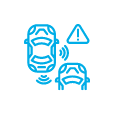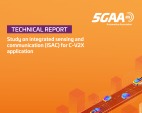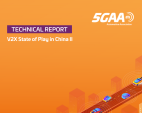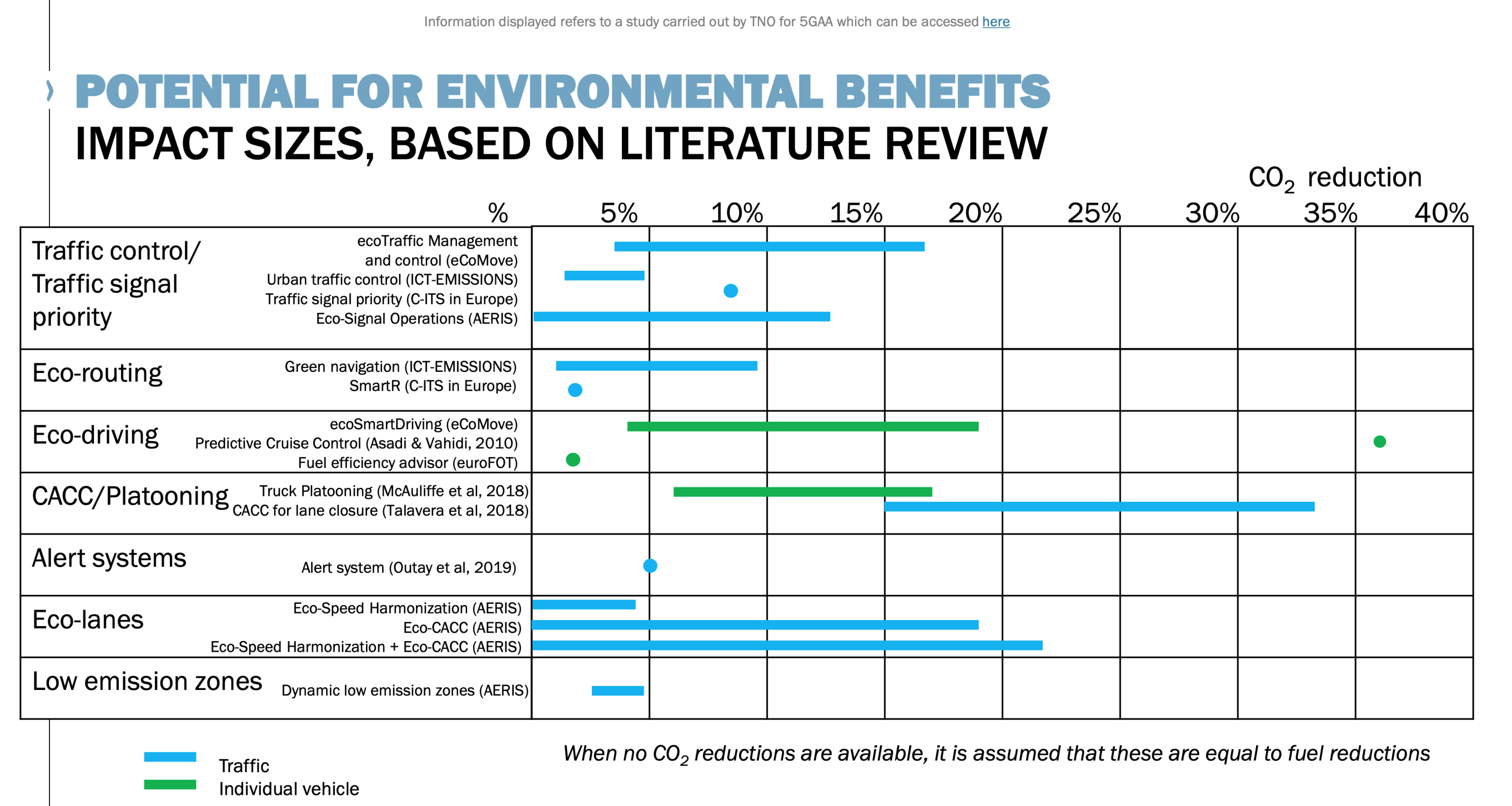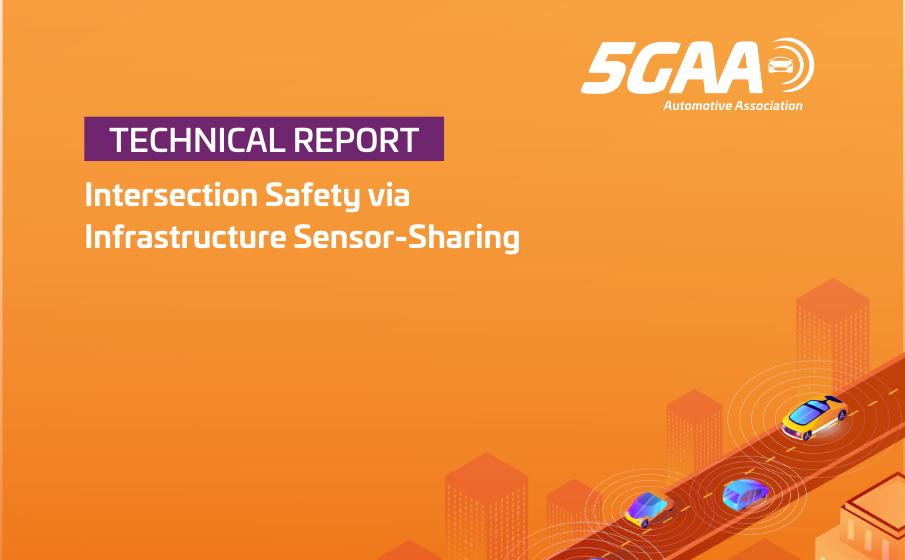
Intersection Safety via Infrastructure Sensor-Sharing
Intersections are a hotspot for traffic fatalities and injuries globally, with nearly a quarter of U.S. traffic fatalities and half of all injuries occurring in these high-risk areas. To address this, the 5GAA has developed a technical report on the ‘InterSafe Service,’ an approach leveraging infrastructure sensor-sharing to increase intersection safety for all road users, especially Vulnerable Road Users (VRUs) like pedestrians and cyclists.
This report explores key use cases, system requirements, and deployment options for integrating Vehicle-to-Everything (V2X) communication technologies with infrastructure sensors. It outlines a framework for developing interoperable, standardised solutions that can operate efficiently within existing Intelligent Transportation System (ITS) spectrums. Crucially, the service is designed to deliver safety benefits even during the early stages of V2X adoption, when only a fraction of vehicles are equipped with these technologies.
The document also provides recommendations for global standards organisations, such as SAE International and ETSI, to expedite the development of system-level profiles. By fostering collaboration across stakeholders, the InterSafe Service has the potential to significantly reduce intersection-related incidents and accelerate the adoption of life-saving technologies worldwide.

Connected Mobility
C-V2X explained
Cellular Vehicle-to-Everything, or C-V2X, is a connected mobility platform that allows vehicles to interact with their surroundings, such as other vehicles, cyclists, pedestrians, road infrastructure, or mobile networks.
To enable connectivity within the broader transport ecosystem, C-V2X uses two complementary transmission modes.
First, direct communications (PC5) works independently of cellular networks and allows vehicles to communicate with other road users (cyclists, pedestrians or other vehicles). Second, network communications (Uu) leverages conventional mobile networks to enable vehicles to receive real-time information about road conditions and local traffic.
By connecting individual vehicles and enabling the development of cooperative intelligent transport systems that reduce congestion and pollution, C-V2X can transform how we look at traffic information to enhance travel and increase road safety.
Leading the new era
of mobility
C-V2X continually evolves over multiple releases in 3GPP. Cellular-V2X (C-V2X) is the umbrella term which encapsulates all 3GPP V2X technologies, including both direct (PC5) and mobile network communications (Uu).
A major milestone was achieved in 2017 by completing LTE-V2X in Release 14, including both direct and mobile network communications delivering basic safety use cases. In 2020, 5G-V2X was completed in Release 16, also combining direct and mobile network communications to enable advanced and automated driving use cases.
Who is 3GPP?
3GPP is a worldwide Standardisation Development Organisation (SDO) developing standards for the different generations of mobile networks: GSM (2G), UMTS (3G), LTE (4G) and 5G, targeting a wide range of consumer and industry applications. When applied in a vehicle connectivity context the acronym V2X (vehicle-to-everything) is added.
C-V2X in detail

C-V2X provides one unified solution for V2V (vehicle-to-vehicle), V2I (vehicle-to-infrastructure), and V2P (vehicle-to pedestrian) operation with V2N (vehicle-to-network) by leveraging existing cellular network infrastructure.
- Device-to-device [1] is Vehicle-to-Vehicle (V2V), Vehicle-to-(Roadway) Infrastructure (V2I) and Vehicle-to-Pedestrian (V2P) direct communication without necessarily relying on network involvement for scheduling.
- Device-to-cell tower is another communications link that enables network resources and scheduling and utilises existing operator infrastructure. Device-to-cell tower communications constitute at least part of the V2I proposition and are essential to end-to-end solutions.
- Device-to-network is the V2N solution using traditional cellular links to enable cloud services to be part and parcel of the end-to-end solution.
In the device-to-device mode (V2V, V2I, V2P) operation, C-V2X does not necessarily require any network infrastructure. It can operate without a SIM, without network assistance and uses GNSS as its primary time synchronisation source.
C-V2X also supports V2N applications using existing cellular networks where other voices and data communications occur. V2N would deliver network assistance and commercial services requiring the involvement of a Mobile Network Operator (MNO).
Collectively, the transmission modes of shorter-range direct communications (V2V, V2I, V2P) and longer-range network-based communications (V2N) comprise what we call Cellular-V2X[2].
[1] Relies on the PC5 interface specified by 3GPP for device-to-device operation.
[2] See 3GPP TR 22.885 Study on LTE Support for Vehicle to Everything (V2X) Services.

MWC Barcelona 2024
The 5G Automotive Association (5GAA) is gearing up for the highly anticipated MWC 2024, scheduled from February 26 to 29 at Fira Gran Via, Barcelona.
Attendees are invited to visit 5GAA at Hall 6, Stand E12, to hear first-hand about the role of our association and membership in revolutionising the mobility landscape. Additionally, an exclusive press tour guided by 5GAA CTO Maxime Flament will offer journalists deeper insights into the latest advancements by 5GAA members.
Opportunities exist to schedule one-to-one meetings with Me Flament, for further insights into the association’s vision and strategies.
For further details, check out our news section.

5GAA Workshop ‘Enabling New Services with Next Generation ITS in Japan’
5GAA is hosting its upcoming workshop, ‘Enabling New Services with Next Generation ITS in Japan,’ in the context of its 29th Meeting Week. The event will take place on February 1st at the Hilton Tokyo, between 9AM and 1PM JPT.
In response to the recent release of Japan’s Frequency Reorganisation Plan by the Ministry of Internal Affairs and Communications, assigning the 5.9 GHz spectrum to V2X for next-generation ITS, this workshop aims to explore the potential implications and opportunities. 5GAA welcomes the decision, which aligns with global spectrum allocation.
The workshop will delve beyond technicalities, offering insights into recent government activities, ongoing development efforts, and expectations for new ITS in Japan. It will also serve as a convergence point for local stakeholders and global industry players, encouraging collaboration and setting the stage for a fruitful discussion Japan’s future in this domain.
Find the full programme here. More information available on our News section.

About us
Connected Mobility for People, Vehicles and Transport Infrastructure
The 5G Automotive Association (5GAA) is a global, cross-industry organisation of companies from the automotive, technology, and telecommunications industries (ICT), working together to develop end-to-end solutions for future mobility and transportation services. Created in September 2016, 5GAA has rapidly expanded to include key players with a global footprint in the automotive, technology and telecommunications industries. This includes automotive manufacturers, tier-1 suppliers, chipset/communication system providers, mobile operators and infrastructure vendors.

5GAA was created to connect the telecom industry and vehicle manufacturers to develop end-to-end solutions for future mobility and transportation services.
Mission
5GAA bridges the automotive and telecommunication industries in order to address society’s connected mobility needs, bringing inclusive access to smarter, safer and environmentally sustainable services and solutions, integrated into intelligent road transportation and traffic management.
A visionary roadmap
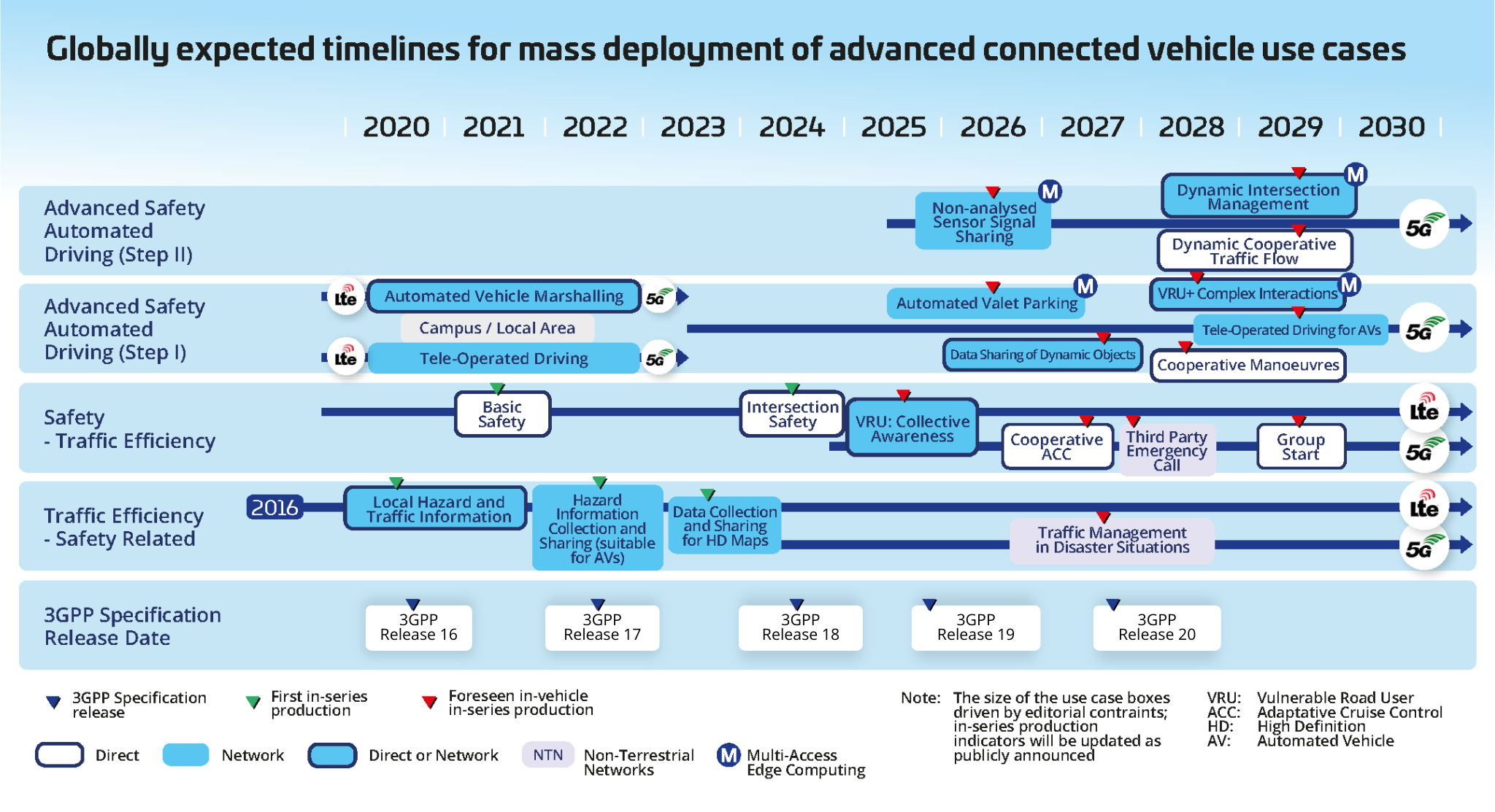
What we do
5GAA is addressing today’s mobility key challenges. With C-V2X technology, 5GAA will revolutionise the mobility ecosystem and the way drivers interact with the world. 5GAA’s ambition is to improve the overall transportation industry to make it safer, greener and more efficient for vehicles, road users and the surrounding infrastructure.

5GAA has defined 4 strategic pillars designing the short and long term goals in very diverse domains contributing to the same ambition: Connected Mobility.

Berlin real-world use cases demonstrate game-changing C-V2X technology
On 25 October 2024 , the 5G Automotive Association (5GAA) demonstrated the latest innovations in the Cellular Vehicle-to-Everything (C-V2X) technology family to help achieve “Vision Zero” for all road users. The demonstrations illustrated the potential of 5G-V2X to enable new use cases integrated across multiple automakers, service providers, and mobile network operators.
For the very first time, 5GAA demonstrated 5G-V2X Direct technology integration in Audi and BMW vehicles with the support of 5GAA members Autotalks, Bosch, Commsignia, and Fraunhofer FOKUS. This demonstration illustrated how technology can alert drivers about pedestrians and cyclists even before they can see them, leveraging sensors and a camera feed from other vehicles. The demonstrations showed the high bandwidth and low latency performance characteristics of 5G-V2X Direct using ETSI Release 2 messages.
5GAA members Bosch, Commsignia, Deutsche Telekom, Ericsson, Keysight Technologies, LG Electronics, Mercedes-Benz and Vodafone, and the Coalition for Cyclist Safety, showcased ready-to-deploy, interoperable applications to increase awareness of vulnerable road users and emergency vehicles on public roads in central Berlin. Safety awareness alerts were delivered via 4G and 5G networks with low latency thanks to Multi-Access-Edge Computing and precise positioning, as verified by Anritsu’s performance measurements. ETSI-standardised messages were shared in real time between apps from various service providers.
“In Germany and across Europe, the ecosystem is ready to leverage the tens of millions of vehicles already connected via mobile networks and is now geared for the 2nd generation technology with 5G-V2X including direct communications,” said 5GAA Chairman Christoph Voigt.
Autotalks and Bosch, together with Commsignia, demonstrated the benefits of collective perception related to vulnerable road users. Ettifos, Keysight Technologies, Rohde & Schwarz and SEA Datentechnik also exhibited 5G-V2X Direct interoperability and conformity solutions and radio performance verification.
To show that C-V2X is about both safety and efficiency, Audi, supported by Commsignia and Autotalks, demonstrated a use case for “cooperative parking” based on 5G-V2X Direct.
In line with 5GAA’s Visionary 2030 Roadmap, 5G is continuously being deployed in many car models and 5G-V2X Direct is expected to be mass-deployed in commercial vehicle models as early as 2026. This week’s event underlined the continuous commitment of major European automakers to 5G-V2X following 5GAA’s Open Statement[1] in 2023.
For more information, watch the video below.

Connected mobility
C-V2X in action
Immerse yourself in the possibilities
The C-V2X technology revolutionises the mobility ecosystem and how drivers interact with the world. It is essential to redefine transportation by providing real-time, highly reliable, and actionable information flows to enable safety, mobility and environmental applications.
5GAA established C-V2X as the critical technology to achieve the level of connectivity required for V2X communication and to be a disruptive force in the automotive market.
C-V2X Testing and Deployment
Following extensive validation testing, off-the-shelf LTE-V2X chipsets, modules, On-Board Units (OBU) and RSU (Roadside Units) have been globally available from multiple vendors since 2018.
These devices feature LTE-V2X direct communications (PC5) and LTE-V2X mobile network communications (Uu). The latest generation of devices features 5G-V2X mobile network communications (Uu) based on 3GPP Release 15.
5GAA regularly compiles an overview of the C-V2X Devices, which we understand are already publicly available on the market (the latest issue in November 2021). This overview is based on publicly available information and does not necessarily include factory-fit telematics/V2X boxes directly under contract with automakers.
The start of in-vehicle commercial deployment (i.e. type-approved vehicles) has begun in 2020-2021. A significant testing schedule is already underway for 5G-V2X, the next generation for cellular technology-based communications solutions, with more than 20 trials and early deployments globally.
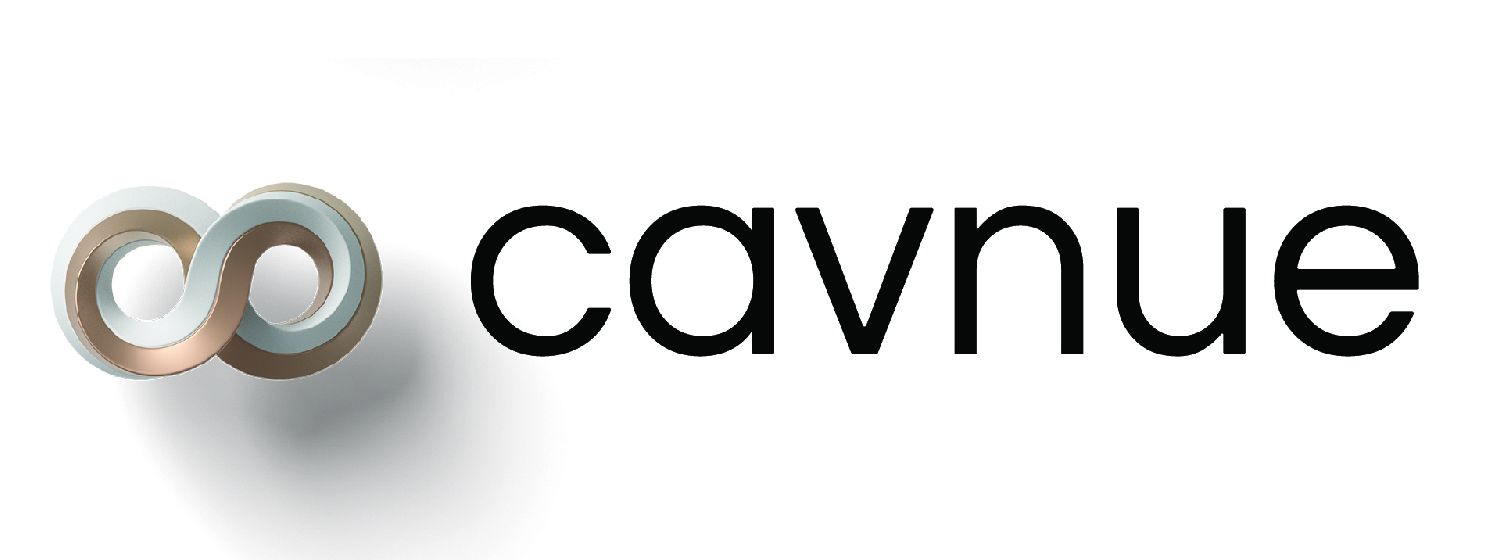
CAVNUE

Sustainability benefits of C-V2X
Cellular Vehicle-to-Everything, or C-V2X, communications will make transportation not only safer and smarter but also more sustainable.
Sustainability has three dimensions: environmental, social and economic.
- Environmental: By helping to make every trip smarter, safer and more efficient, C-V2X helps reduce congestion and accidents, thereby reducing air pollution, noise pollution and energy use.
- Social: Saving lives and avoiding injuries are clear social benefits. By enabling real-time communication between pedestrians, cyclists, traffic infrastructure and moving vehicles, including motorcycles and electric scooters, C-V2X will help avoid accidents that otherwise would result in injuries and deaths.
- Economic: By enabling more efficient mobility, C-V2X will save people and employers billions of man-hours currently wasted in traffic jams. Those man-hours can then be dedicated to more rewarding activities.
C-V2X also enables the growth of autonomous mobility, which in turn offers even greater sustainability benefits, for example mobility-as-a-service offerings.
To learn more, watch the short video.

Connected Mobility
Sustainability
Sustainability benefits of C-V2X
Cellular Vehicle-to-Everything, or C-V2X, communications will make transportation not only safer and smarter but also more sustainable.
Sustainability has three dimensions: environmental, social and economic.
C-V2X ticks all three boxes:
- Environmental: By helping to make every trip smarter, safer and more efficient, C-V2X helps reduce congestion and accidents, thereby reducing air pollution, noise pollution and energy use.
- Social: Saving lives and avoiding injuries are clear social benefits. By enabling real-time communication between pedestrians, cyclists, traffic infrastructure and moving vehicles, including motorcycles and electric scooters, C-V2X will help avoid accidents that otherwise would result in injuries and deaths.
- Economic: By enabling more efficient mobility, C-V2X will save people and employers billions of man-hours currently wasted in traffic jams. Those man-hours can then be dedicated to more rewarding activities.
C-V2X also enables the growth of autonomous mobility, which in turn offers even greater sustainability benefits, for example mobility-as-a-service offerings.
To learn more, watch the short video or scroll down for more details.
C-V2X and Sustainability in detail
ENVIRONMENTAL BENEFITS

- Transport still represents about 25% of Europe’s total CO2 emissions. By helping to make every trip smarter, safer and more efficient, C-V2X helpsreduce congestion and accidents, thereby reducing energy use, noise pollution and air pollution.
- C-V2X can help all vehicles operate and deliver people and goods more efficiently, thereby reducing pollution and optimizing the use of valuable energy resources.
- INRIX calculated that each second of reduced delays at traffic signals across the United States would translate to an annual reduction of 800,000 metric tons of CO2.
- Connected vehicle technology can help electric cars calculate an energy-optimised route to a charging station that’s not necessarily the fastest or nearest but requires the least energy to reach.
- Examples of environmental benefits enabled by C-V2X technologies include:
- Current technology permitting smarter routing for all vehicles in both urban and rural areas, for example via automated traffic routing, road, bridge, tunnel and parking availability updates and smart parking.
- Future technology permitting “green waves” for emergency vehicles, cars, trucks, lorries and other vehicles instead of stop-and-go traffic.
- Future technology facilitating manoeuvres and cooperation in traffic.
- For more detailed information, please see TNO’s report for 5GAA on the Environmental Benefits of C-V2X.
SOCIAL BENEFITS

- By enabling real-time communication between pedestrians, cyclists, traffic infrastructure and moving vehicles, including motorcycles, C-V2X will help avoid accidents that otherwise would result in injuries and deaths.
- According to the World Health Organisation, there were 1.35 million traffic deaths globally in 2016, the latest year for which global data are available. Road traffic deaths are a leading cause of death among young people, in particular.
- In the European Union, there were about 20,608 road deaths in 2023, or about 46 road deaths per million inhabitants.
- In the United States, an estimated 40,990 people died in road accidents in 2023. The United States Department of Transportation has set an ambitious goal of zero traffic deaths, in part by leveraging advanced technologies to prevent accidents in the first place.
- It says: “The U.S. Department of Transportation’s National Roadway Safety Strategy specifies that zero is the only acceptable number of deaths and serious injuries on our roadways. USDOT is committed to taking substantial, comprehensive action to achieve this goal.”
- By providing real-time hazard notifications and enabling connected cooperative driving, C-V2X makes transportation safer for all road users, including cyclists. As C-V2X makes the roads safer, more people may feel confident in choosing cycling as their primary mode of transportation.
- A U.S. DOT pilot study demonstrated that C-V2X technology can prevent accidents and injury for vulnerable road users.
- Green waves and corridors for emergency vehicles can help save lives and reduce injuries, allowing people to lead longer, healthier and more fulfilling lives.
- Response times are critical for emergency vehicles and first responders to save lives. A 2020 study showed that “green waves” at traffic lights could reduce response times by as much as 30% with little impact on overall traffic conditions.
- By enabling more efficient mobility, C-V2X will save commuters billions of man-hours currently wasted in stressful traffic jams.Those man-hours can be dedicated to more enjoyable and rewarding activities such as doing sports, hobbies, volunteering, education or spending time with friends and family.
- In Europe, the average driver in some cities loses more than 150 hours per year stuck in traffic jams.
- Americans lost as much as 3.4 billion hours in traffic in total in 2021.
- C-V2X helps connect other modes of transport with one another to facilitate a real multi-modal transportation system.
ECONOMIC BENEFITS

- By enabling automated driving and mobility as a service, C-V2X will help create new products and services that help drive more sustainable economic growth.
- For example, anonymous data collected through C-V2X can help governments and policymakers develop more effective infrastructure maintenance programmes and traffic plans.
- By enabling more efficient mobility, C-V2X will save employers and entrepreneurs billions of man-hours currently wasted in traffic jams.Those man-hours can then be dedicated to more rewarding activities.
- For commercial vehicles, C-V2X can help optimise delivery routes and schedules and reduce the number of empty or partially loaded trips. Efficient route management reduces energy use and pollution.
- The deployment of C-V2X technologies in vehicles can increase demand for 5G and future networks, each of which will be more energy-efficient than the technologies they replace.
Want to learn more?
If you want to learn more about the timeline for the introduction of next-generation C-V2X communications technologies, including those with clear environmental benefits, please see our latest C-V2X technology Roadmap here.




